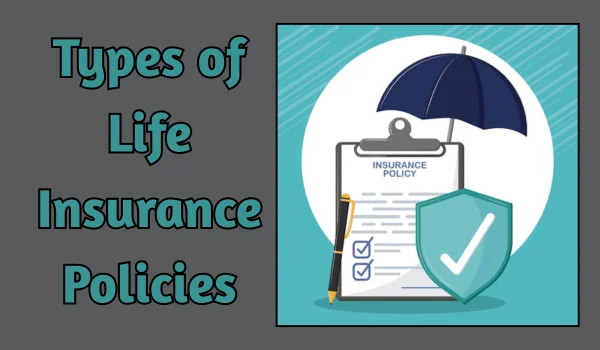Life insurance is one of the foundational pillars of financial planning in India. At its core, life insurance provides a financial safety net: when the policyholder dies (or in some cases survives to maturity), the insurer pays out a sum to the beneficiary or the insured. In the Indian context, life insurance also often includes a savings/investment element (especially with longer‐term policies), tax advantages, and optional riders.
Understanding the types of life insurance policies is essential before buying one, because different types serve different purposes: protection, savings, retirement planning, legacy, etc. What suits one person (say a young single professional) may not suit another (say someone nearing retirement with dependents).
Below, I explain the main types of life insurance policies in India, their features, advantages, disadvantages, and how to choose among them.
Broad Classification: Term vs. Non-Term (Savings / Investment / Permanent)

A useful first division is:
- Term life insurance (pure protection)
- Non-term / “permanent” life insurance—which includes policies that combine protection + savings/investment components
This is conceptually similar to the classification in many global markets: “term” policies vs. “cash value / permanent” policies.
Let us explore each major type, then subtypes under them, and then specific variants common in India.
1. Term Insurance Plans (Pure Protection)
What is term insurance?
A term insurance plan is a life insurance policy for a fixed period (the “term”). If the insured dies during the term, the beneficiary receives the sum assured. If the insured survives the term, typically nothing is paid (unless special features apply). It is purely for protection.
Because there is no savings/investment or maturity benefit, term policies generally have the lowest cost (premium) per unit of coverage.
Variants of term plans
- Level term: The sum assured remains constant over the term.
- Decreasing term: Sum assured decreases over time (often used to match a declining liability like a home loan).
- Increasing term: Sum assured increases with time (inflation adjustments).
- Return of Premium (RoP) term: If you survive the term, the insurer returns all or part of the premiums paid.
- Convertible term: You can convert (during the term) into a permanent (non‐term) plan without health check, usually up to a certain age.
- Renewable term: After the initial term ends, you can renew for another term (with higher premiums).
Pros
- Very affordable protection.
- Straightforward to understand.
- Helps bridge protection gap (income replacement, liabilities) without burdening budget.
Cons
- No maturity benefit (unless RoP).
- Once term ends, needing new coverage can be expensive (due to age, health).
- You might “lose” your money (premiums) if you outlive the term (unless RoP).
In India, many insurers and LIC (Life Insurance Corporation) offer term plans. For example, LIC’s Digi Term is one example.
2. Non-Term / Permanent / Savings-Oriented Life Insurance Plans
These plans combine life cover with a savings or investment component. These are sometimes called “participating / non-participating / unit-linked / endowment / money back / whole life / annuity” types. In Indian usage, you’ll find multiple names and hybrids. The key trait is that policyholders may receive survival benefits, bonuses, or maturity proceeds in addition to death benefit.
Below are the major types in India:
Endowment Plans
An endowment policy provides life cover + maturity benefit. If you survive the policy term, you get the maturity amount; if you die earlier, the beneficiaries get the sum assured (plus bonuses).
These are popular in India because they combine discipline in saving + protection. Many traditional (non‐ULIP) endowment plans are “participating,” i.e., policyholders get declared bonuses (reversionary bonuses, terminal bonuses) depending on insurer profits.
Pros
- Guaranteed maturity benefit (plus bonuses).
- Dual benefit: protection + savings.
- Less volatile risk compared to pure market‐linked plans.
Cons
- Premiums are higher compared to term plans for the same sum assured.
- The return (after accounting for locking in, costs) may be moderate.
- Liquidity is limited; surrendering early may lead to low returns or penalties.
Many Indian insurers (and LIC) offer endowment plans.
Whole Life (Whole Life / Full Life) Plans
A whole life insurance is designed to provide coverage for the insured’s entire lifetime (or up to a high age, e.g., 99 or 100). The policy typically pays the death benefit when the insured dies whenever that is.
Some whole life plans may also offer a maturity benefit at a certain advanced age.
Pros
- Lifelong protection (not limited to term).
- Good for estate planning or legacy goals.
- May build cash value or bonus in long term policies.
Cons
- Premiums are relatively high (because coverage is for life).
- Might not be ideal if your primary need is only for a certain period.
- Investment returns component may be moderate.
In India, whole life plans are less common than term or endowment, but they exist among established life insurers.
Unit Linked Insurance Plans (ULIPs)
ULIPs are life insurance products where part of the premium goes toward life coverage, and part is invested in market-linked funds (e.g., equity, debt, hybrid). The returns depend on the performance of the underlying fund(s).
ULIPs allow switching between funds (subject to limits), partial withdrawals, etc. They thus combine protection + investment flexibility.
Pros
- Potential for high returns (subject to market risk).
- Flexibility in fund choice, switching, partial withdrawal (after lock-in).
- Transparent (you see NAVs) and some tax benefits (if held for minimum periods).
Cons
- Market risk: returns are not guaranteed.
- Higher costs (fund management charges, policy charges).
- Lock-in period (typically 5 years in India) before withdrawals.
ULIPs are very common in India nowadays, and many insurers promote them as “wealth + protection” vehicles.
Money Back Plans
Money back policies are a variant of endowment where the policy pays periodic “survival benefit” (a fixed percentage of sum assured at intervals) during the policy term, and the remaining amount at maturity. If death occurs anytime, full sum assured is paid (or sometimes sum assured + bonuses).
They provide liquidity during the term via these payouts.
Pros
- Periodic returns during the policy term (helps liquidity).
- Return of part of your money even before maturity.
- Protection + partial cash flow.
Cons
- Because part of your benefit is given early, the maturity benefit is lowered.
- Premiums are relatively higher vs simple endowment.
- Less investment upside (compared to ULIP), more rigidity.
Many traditional life insurers in India offer money back plans as a middle path between pure protection and pure savings.
Pension / Annuity (Retirement) Plans
These life insurance plans focus on retirement income rather than death benefit. The insured builds up a corpus over the accumulation period (deferred annuity) and then receives periodic payments (annuity) after retirement or an agreed date.
Variants:
- Immediate annuity: You pay a lump sum (single premium) and start receiving annuity payments immediately (or within 1 year).
- Deferred annuity: You accumulate over a period, and after vesting you receive annuity. It may combine with an endowment or ULIP during accumulation phase.
Sometimes, if the annuitant dies, there may be a death benefit or beneficiary payments depending on contract.
Pros
- Reliable retirement income stream (like a pension).
- Can plan retirement cash flows.
- Helps mitigate longevity risk (outliving one’s savings).
Cons
- Return may be lower than equities.
- Inflation can erode purchasing power (unless inflation-adjusted annuities used).
- Surrender or liquidity is limited post vesting.
Thus, for someone whose priority is income during old age, annuity products via life insurers are very useful.
Group Life Insurance
Group life insurance covers a group (for example employees of a company) under a single contract. The employer (or plan sponsor) arranges coverage for all eligible employees. Premiums are lower due to economies of scale and simplified underwriting.
Group policies generally provide death benefit; some may include other features (disability, critical illness). These are not usually meant for individual investment returns.
Pros
- Low or subsidized cost.
- Easy enrollment (often without medical tests or minimal screening).
- Provides baseline protection for employees.
Cons
- Coverage typically reduces after exit or retirement.
- Beneficiaries must claim through employer / plan.
- Limited customization (the same cover terms for all).
Group life insurance is commonly provided as employee benefits or required coverage for loans.
Hybrid / Combo / Other Variants
Some modern life insurance products are hybrids or combinations, blending features of the types above. Examples:
- Term + Investment rider: A pure term base + a rider which invests in funds.
- Unit-linked endowment: ULIP + guaranteed maturity component.
- Term with Return of Premium (already mentioned).
- Increasing term + inflation indexation.
- Child endowment / education plans: tailored for children’s future (tuition, etc.), where parent is insured and child is beneficiary. This is a variant of endowment/ULIP for children.
These hybrid products aim to offer more flexibility, risk management, or customization.
Key Features / Riders / Add-Ons
When you examine any life insurance plan, apart from the basic type, consider the following:
- Riders / add-on covers: e.g., accidental death benefit, critical illness cover, premium waiver on disability, accidental disability benefit, term assurance riders, etc.
- Bonus mechanism (for participating / endowment plans)
- Liquidity / surrender value: How much you get if you terminate early.
- Partial withdrawals / fund switching (for ULIPs).
- Premium payment modes: single premium, limited pay, regular pay.
- Grace period, free look period, revival clause.
- Tax benefits under Indian tax laws (see below).
Tax Benefits in India
Life insurance policies in India enjoy various tax benefits, subject to conditions under the Income Tax Act:
- Section 80C: Premiums paid on life insurance (for self, spouse, children) are deductible up to ₹1,50,000 per annum (under old regime).
- Section 10(10D): The maturity proceeds, death benefits, and bonuses (if any) are generally tax-free (if certain conditions are satisfied).
- Other sections: Some riders or health premiums may also fall under other deductions (e.g. Section 80D).
However, tax laws change, so always check the current provision and ensure policy complies with conditions (like premium not exceeding a certain percent of sum assured).
Choosing the Right Type: A Stepwise Approach
Given so many types, here is a pragmatic way to choose:
- Assess your primary objective:
• If pure protection (income replacement, liabilities) is priority → consider term.
• If you want a savings component or maturity returns → consider endowment / ULIP / money back.
• If your need is for lifetime cover or legacy / estate → whole life may suit.
• For retirement income → annuity / pension plans.
• If you have employer coverage, supplement with individual policy (possibly term + something else). - Time horizon:
If your obligations (kids’ education, loan) have a time limit, term or endowment might suffice.
If your aim is to cover your full life or leave a legacy, then a permanent plan is warranted. - Risk appetite & investment horizon:
If comfortable with market risk and want higher returns → ULIP or hybrid.
If prefer stability → traditional endowment or whole life. - Affordability / premium budget:
Term plans are cheapest; permanent ones are costlier. Always ensure the premium is sustainable for many years. - Liquidity & flexibility needs:
If you might need money during the policy term (for emergencies) → better have money back or ULIP with partial withdrawals (after lock-in). - Tax & regulatory conditions:
Ensure the plan qualifies under Section 10(10D) etc., and understand surrender charges. - Compare cost, returns & reviews:
Look at internal rate of return (IRR) or yield, the insurer’s claim settlement ratio, reputation, charges, bonus history (for non‐ULIP plans), and clarity in contract. - Riders & add-ons:
Add riders like waiver of premium or critical illness as per need, but ensure they do not inflate the premium too much.
Types and Features
| Type / Variant | Primary Objective | Death Benefit + Maturity | Pros | Cons / Considerations | Typical Use Case |
| Term (Level / Decreasing / Increasing / RoP etc.) | Pure protection | Death benefit only (unless RoP) | Very low cost, easy to understand | No maturity benefit; renewal cost may rise | Young breadwinner wanting max cover at low cost |
| Endowment | Protection + Savings | Death benefit + maturity + bonuses | Guarantees + bonuses, disciplined saving | Moderate returns, limited liquidity | Medium term goals, disciplined savings |
| Whole Life | Lifetime protection / legacy | Death benefit (when you die) | Lifetime cover, estate planning | Higher cost, less flexibility | Cover entire life, leave legacy |
| ULIP | Protection + investment in market | Death benefit + NAV-based investment value | High upside, flexibility | Market risk, charges, lock-in | For investors willing to take risk |
| Money Back | Periodic payouts + cover | Periodic survival payouts + death benefit | Liquidity over term | Lower maturity, higher cost | For those needing periodic cash flow |
| Annuity / Pension | Retirement income | Periodic annuity payments | Regular income in old age | Return may lag inflation, limited liquidity | People seeking post-retirement cash flow |
| Group Life | Cover for group / employees | Death benefit | Low cost, ease of access | Less flexibility, coverage often linked to employment | Employee benefits, loan collateral cover |
Caveats & Practical Advice
- Always read the policy document, especially exclusions (suicide clause, waiting periods, etc.).
- Check the claim settlement ratio, financial strength, bonus history of the insurer.
- Avoid buying life insurance just for tax saving; the primary motive should be protection or financial goals.
- Reassess your cover needs every few years (income, liabilities, dependents may change).
- Be careful of high commission / hidden charges (especially in ULIPs).
- Understand the surrender / exit conditions — what happens if you stop paying premiums or cancel early.
- Use online calculators / agent advice to determine the sum assured (for example 10–15× your annual income or based on future obligations).
- Make beneficiary nominations, update them when life changes (marriage, birth, etc.).
Conclusion
In India, the life insurance landscape offers a rich variety of policy types—ranging from simple term insurance for pure protection, to hybrid ULIPs, endowments, money back plans, whole life, pensions, and group policies. Each type has its own risk–return equation, cost structure, liquidity, and suitability depending on your stage in life, obligations, risk appetite, and financial goals.
The best approach is to map your goals first (e.g. protect dependents, save for child’s education, retire with income, leave legacy), then select a policy type (or combination) that fits that goal, and finally compare across insurers on cost, returns, terms, and reliability.




